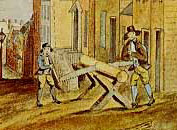Origination Information for the People of Colonial Albany
the in-progress thoughts
of
Stefan Bielinski
More than two thirds of the 16,000 people who meet the criteria for inclusion in the People of Colonial Albany study population were actually born within the city of Albany. Our community-based research program has told us much about their origins and backgrounds. These boys and girls represent the core city population - born within the defined city limits.
At the same time, please be aware that almost half of those Albany children did not live long enough to reach adulthood, are mostly historically mute, and thus must take a back seat to the adults - generally speaking that is! For the sometimes silent majority of the native born "Albanians," our sweep of community-based resources has yielded substantial material with which to sketch out their life course profiles.
However, for the original settlers (in the community at its founding in 1664) and for those newcomers who came to Albany afterwards, their pre-Albany stories are far more challenging. In the days before the World Wide Web, searching for origins and backgrounds of newcomers was a far more arduous task when accessibility to a comparative handful of printed family-based resources, actual legwork for research, or what I still recall as tedious and frustrating correspondence, made origins research a veritable "needle-in-a-haystack" experience.
Newcomers came into the community on a regular basis (true then as well as now). A small percentage of those who entered the city limits stayed on for a year, a decade, or a lifetime. Finding the answer to the marquee question on this page is part of every biographical initiative. We now start with an Internet search under a range of spellings and identity terms. That initial search invariably leads in so many interesting directions. Stay tuned for much more on this task.
Finally (for now), our quest for places of origin for our early Albany people frequently and quickly has led us to a research type of publication/printing/webwork that we call (a term of convenience) a Traditional Source. This general resource type is frequently considered and discussed on this website.

Home | Site Index | Navigation | Email | New York State Museum
silently posted: 10/29/10; last revised 5/18/17